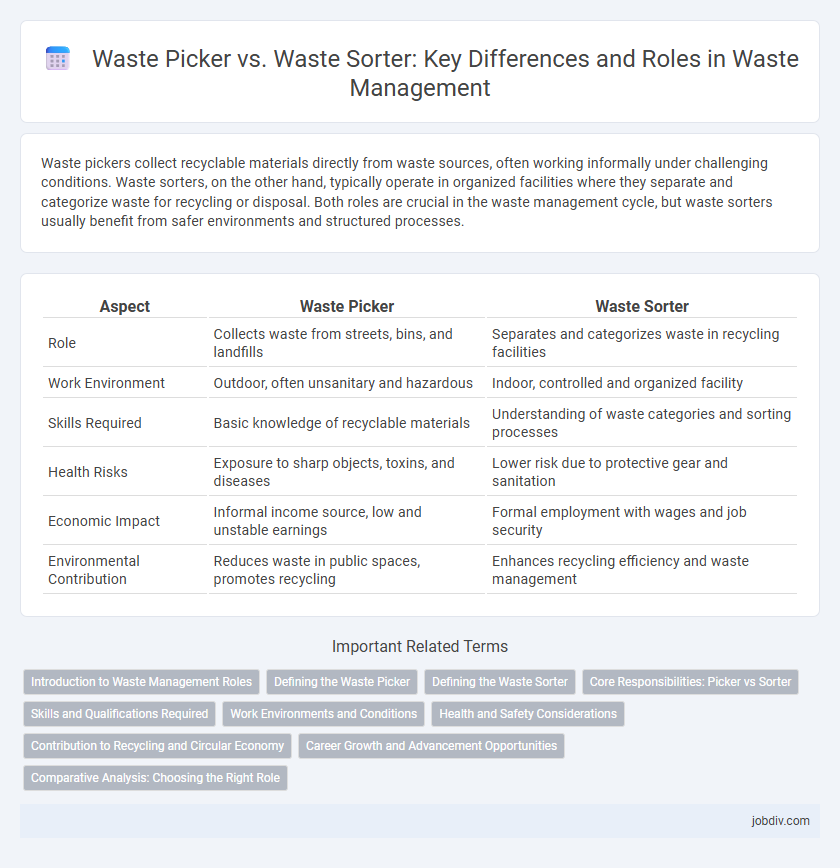Waste pickers collect recyclable materials directly from waste sources, often working informally under challenging conditions. Waste sorters, on the other hand, typically operate in organized facilities where they separate and categorize waste for recycling or disposal. Both roles are crucial in the waste management cycle, but waste sorters usually benefit from safer environments and structured processes.
Table of Comparison
| Aspect | Waste Picker | Waste Sorter |
|---|---|---|
| Role | Collects waste from streets, bins, and landfills | Separates and categorizes waste in recycling facilities |
| Work Environment | Outdoor, often unsanitary and hazardous | Indoor, controlled and organized facility |
| Skills Required | Basic knowledge of recyclable materials | Understanding of waste categories and sorting processes |
| Health Risks | Exposure to sharp objects, toxins, and diseases | Lower risk due to protective gear and sanitation |
| Economic Impact | Informal income source, low and unstable earnings | Formal employment with wages and job security |
| Environmental Contribution | Reduces waste in public spaces, promotes recycling | Enhances recycling efficiency and waste management |
Introduction to Waste Management Roles
Waste pickers collect recyclable materials directly from waste sources, playing a crucial role in informal waste management by reducing landfill volume and promoting recycling. Waste sorters work within organized facilities, separating waste into categories for further processing, enhancing material recovery efficiency. Both roles contribute significantly to sustainable waste management by facilitating resource recovery and minimizing environmental impact.
Defining the Waste Picker
Waste pickers are individuals who collect recyclable materials directly from waste sources such as streets, landfills, and bins, often working informally without formal employment contracts. Unlike waste sorters who typically operate within controlled environments like recycling facilities to separate materials by type, waste pickers play a crucial role in the initial recovery and diversion of waste from landfills. Their activities contribute significantly to resource recovery, environmental sustainability, and informal sector livelihoods in urban waste management systems.
Defining the Waste Sorter
A waste sorter is a professional responsible for categorizing and separating recyclable and non-recyclable materials at facilities or collection points to streamline waste management processes. Unlike waste pickers who collect discarded items from various locations, waste sorters operate primarily within controlled environments to ensure materials are properly classified for recycling, composting, or disposal. Effective waste sorting improves recycling rates and reduces contamination, playing a critical role in sustainable waste management systems.
Core Responsibilities: Picker vs Sorter
Waste pickers primarily collect recyclable and reusable materials directly from streets, landfills, and waste bins, focusing on salvaging valuable items to reduce landfill volume. Waste sorters work in controlled facilities, systematically categorizing collected waste into various materials like plastics, metals, and paper to optimize recycling processes. Both roles are critical in the waste management chain, yet pickers engage in initial recovery, while sorters handle organized segregation to ensure efficient recycling.
Skills and Qualifications Required
Waste pickers require strong knowledge of local waste types, physical endurance, and basic sorting skills to efficiently collect recyclable materials from diverse environments. Waste sorters need specialized training in material classification, quality control, and safety protocols to accurately separate waste at facilities, often requiring the ability to operate sorting machinery and adhere to strict health guidelines. Both roles demand an understanding of environmental regulations and commitment to sustainable waste management practices.
Work Environments and Conditions
Waste pickers typically operate in informal, outdoor environments such as landfills, streets, and dumpsites, often facing hazardous conditions with limited safety equipment and exposure to toxic materials. Waste sorters generally work in controlled indoor facilities or recycling centers where conditions are more regulated, with access to protective gear and mechanized sorting systems that reduce physical strain and health risks. Both roles involve manual labor, but waste sorters benefit from structured environments that aim to improve worker safety and efficiency.
Health and Safety Considerations
Waste pickers face significant health risks due to direct exposure to hazardous materials, lack of protective equipment, and unsanitary working conditions, increasing their vulnerability to infections and injuries. Waste sorters typically operate in more controlled environments with regulated safety protocols, including the use of personal protective equipment (PPE) and access to hygiene facilities, reducing health hazards. Implementing comprehensive health and safety measures is crucial to protect both waste pickers and sorters from occupational diseases and accidents.
Contribution to Recycling and Circular Economy
Waste pickers play a crucial role in recycling by collecting and diverting recyclable materials from landfills, significantly reducing environmental pollution and supporting the circular economy through informal yet essential material recovery. Waste sorters enhance this process by systematically separating mixed waste at recycling facilities, improving the quality and efficiency of recycled materials for reuse in manufacturing. Together, waste pickers and sorters form an integral part of sustainable waste management systems, driving resource efficiency and lowering demand for virgin materials in the circular economy.
Career Growth and Advancement Opportunities
Waste pickers often face limited career growth due to informal work conditions and lack of formal training, restricting their ability to access higher-paying roles. Waste sorters typically work in structured environments with potential for skill development, enabling advancement into supervisory or operational management positions. Investing in training programs and formal recognition can significantly enhance career opportunities for both waste pickers and sorters.
Comparative Analysis: Choosing the Right Role
Waste pickers manually collect recyclable materials from public spaces, often working informally and facing health and safety challenges, whereas waste sorters operate within organized facilities, systematically separating waste to enhance recycling efficiency and reduce contamination. Choosing the right role depends on factors like employment stability, health risks, and impact on waste management systems; waste sorters typically benefit from structured environments and protective measures, while waste pickers contribute significantly to informal recycling economies but encounter greater vulnerabilities. Understanding these distinctions is crucial for policymakers aiming to improve waste management strategies and support sustainable livelihoods in the sector.
Waste Picker vs Waste Sorter Infographic

 jobdiv.com
jobdiv.com